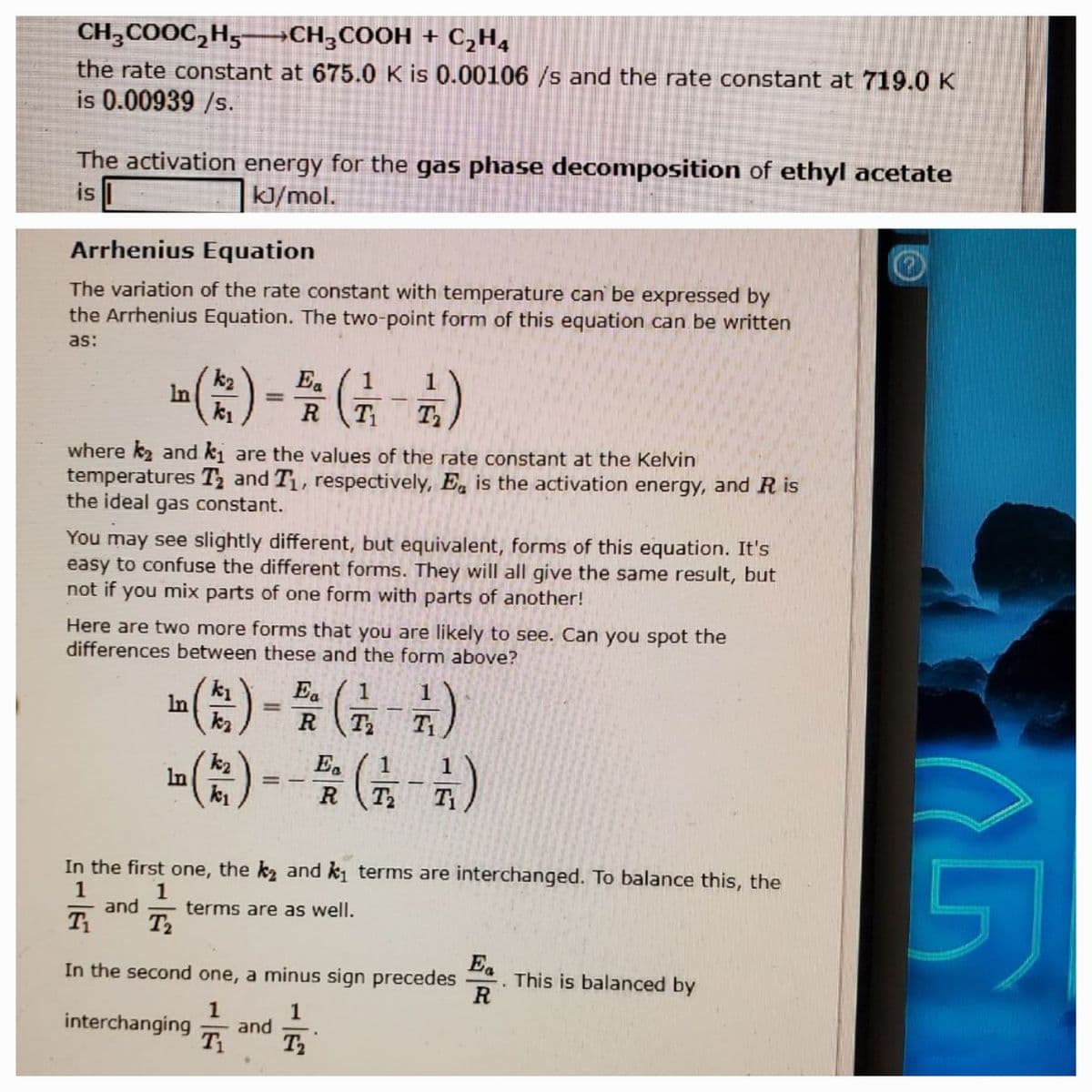CH,COOC,H, the rate constant at 675.0 K is 0.00106/s and the rate constant at 719.0 K is 0.00939 /s. +CH;COOH + C,H, The activation energy for the gas phase decomposition of ethyl acetate is | kJ/mol.
CH,COOC,H, the rate constant at 675.0 K is 0.00106/s and the rate constant at 719.0 K is 0.00939 /s. +CH;COOH + C,H, The activation energy for the gas phase decomposition of ethyl acetate is | kJ/mol.
Chemistry: The Molecular Science
5th Edition
ISBN:9781285199047
Author:John W. Moore, Conrad L. Stanitski
Publisher:John W. Moore, Conrad L. Stanitski
Chapter11: Chemical Kinetics: Rates Of Reactions
Section: Chapter Questions
Problem 115QRT
Related questions
Question
100%

Transcribed Image Text:CH,COOC,H,–CH,COOH + C,H,
the rate constant at 675.0 K is 0.00106 /s and the rate constant at 719.0 K
is 0.00939 /s.
The activation energy for the gas phase decomposition of ethyl acetate
is
kJ/mol.
Arrhenius Equation
The variation of the rate constant with temperature can be expressed by
the Arrhenius Equation. The two-point form of this equation can be written
as:
"(수)- (뉴
Ea
In
T1
where k and kj are the values of the rate constant at the Kelvin
temperatures T2 and T1, respectively, E is the activation energy, and R is
the ideal gas constant.
You may see slightly different, but equivalent, forms of this equation. It's
easy to confuse the different forms. They will all give the same result, but
not if you mix parts of one form with parts of another!
Here are two more forms that you are likely to see. Can you spot the
differences between these and the form above?
Ea
k1
In
ka
ln () --G
k2
Ea
R
T2
In the first one, the k2 and ki terms are interchanged. To balance this, the
1
and
T2
terms are as well.
In the second one, a minus sign precedes
Ea
This is balanced by
1
1
interchanging
and
T
Expert Solution
This question has been solved!
Explore an expertly crafted, step-by-step solution for a thorough understanding of key concepts.
This is a popular solution!
Trending now
This is a popular solution!
Step by step
Solved in 3 steps with 1 images

Knowledge Booster
Learn more about
Need a deep-dive on the concept behind this application? Look no further. Learn more about this topic, chemistry and related others by exploring similar questions and additional content below.Recommended textbooks for you

Chemistry: The Molecular Science
Chemistry
ISBN:
9781285199047
Author:
John W. Moore, Conrad L. Stanitski
Publisher:
Cengage Learning

Chemistry: Principles and Practice
Chemistry
ISBN:
9780534420123
Author:
Daniel L. Reger, Scott R. Goode, David W. Ball, Edward Mercer
Publisher:
Cengage Learning

Chemistry: An Atoms First Approach
Chemistry
ISBN:
9781305079243
Author:
Steven S. Zumdahl, Susan A. Zumdahl
Publisher:
Cengage Learning

Chemistry: The Molecular Science
Chemistry
ISBN:
9781285199047
Author:
John W. Moore, Conrad L. Stanitski
Publisher:
Cengage Learning

Chemistry: Principles and Practice
Chemistry
ISBN:
9780534420123
Author:
Daniel L. Reger, Scott R. Goode, David W. Ball, Edward Mercer
Publisher:
Cengage Learning

Chemistry: An Atoms First Approach
Chemistry
ISBN:
9781305079243
Author:
Steven S. Zumdahl, Susan A. Zumdahl
Publisher:
Cengage Learning

Chemistry
Chemistry
ISBN:
9781305957404
Author:
Steven S. Zumdahl, Susan A. Zumdahl, Donald J. DeCoste
Publisher:
Cengage Learning


Chemistry & Chemical Reactivity
Chemistry
ISBN:
9781133949640
Author:
John C. Kotz, Paul M. Treichel, John Townsend, David Treichel
Publisher:
Cengage Learning